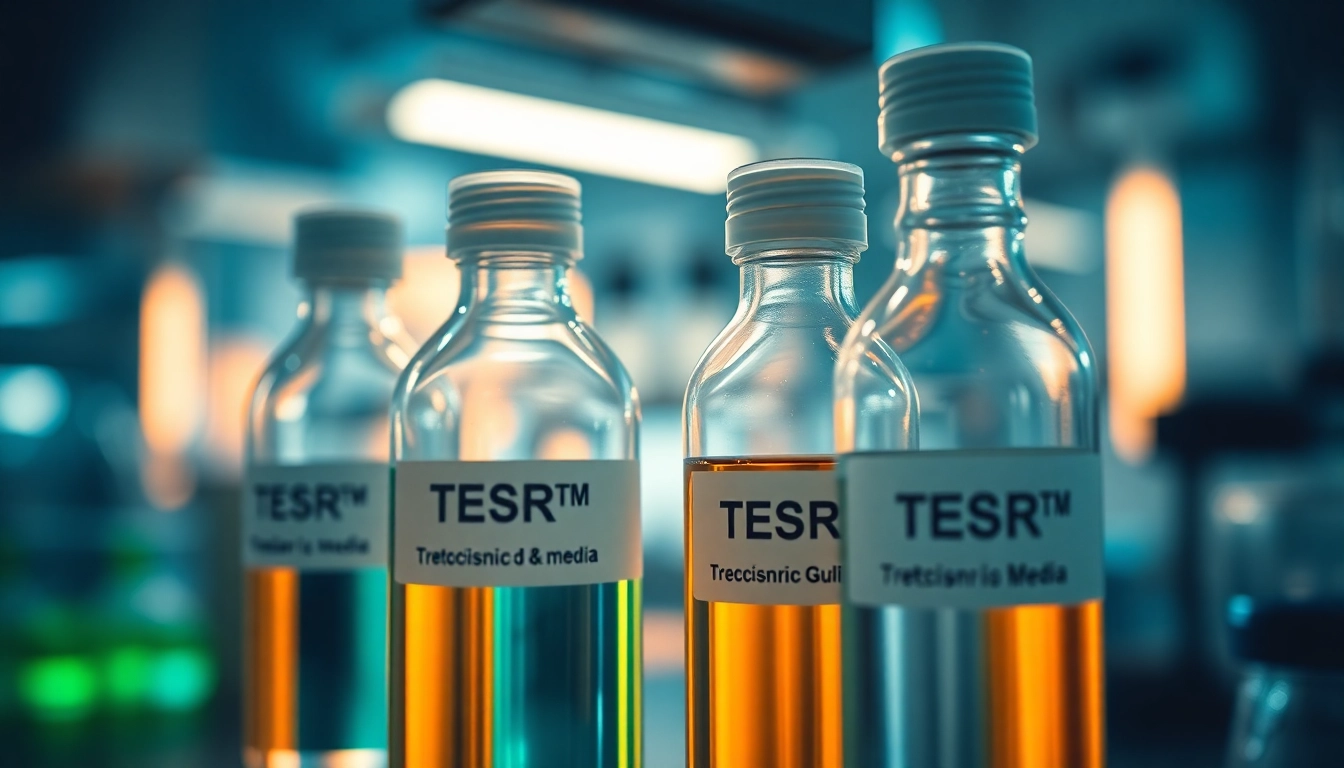Understanding TeSR™ Feeder-Free Media
What is TeSR™? Overview of Formulations
TeSR™ is a series of specialized feeder-free media that provides a robust and reproducible environment for the culture of human pluripotent stem cells (hPSCs), including embryonic stem cells (ESCs) and induced pluripotent stem cells (iPSCs). Developed through proprietary formulations derived from the laboratory of Dr. James Thomson, TeSR™ media has become essential for researchers aiming for optimal conditions in stem cell maintenance, differentiation, and reprogramming.
The TeSR™ family includes various formulations, such as all check, mTeSR™1, mTeSR™ Plus, TeSR™-AOF, TeSR™-E6, TeSR™-E5, and several others tailored for specific applications. Each formulation is crafted to meet unique research needs, emphasizing factors like sensitivity to environmental conditions and the preservation of stem cell characteristics through enhanced buffering systems and minimized component variation.
Advantages of Feeder-Free Culturing
The transition to feeder-free stem cell culture offers significant advantages over traditional methodologies reliant on feeder layers. Firstly, feeder-free systems eliminate the variability associated with feeder cell-derived cues, providing a chemically-defined, standardized environment that promotes consistency across experiments. This ensures reproducibility, which is crucial for advancing research in stem cell biology.
Moreover, feeder-free media support higher cell viability and pluripotency while reducing the risk of contamination from feeder cells. In addition, the optimized formulations streamline maintenance protocols, allowing researchers to achieve longer intervals between media changes without compromising cell integrity.
Essential Components and Their Functions
TeSR™ media formulations contain a symphony of carefully selected components. Key ingredients include:
- Basal Medium: The foundation, often consisting of DMEM/F12 or similar media, provides vital nutrients.
- Growth Factors: Essential proteins like Fibroblast Growth Factor 2 (FGF2) are included to promote stem cell proliferation and maintain pluripotency.
- Cytokines: These immune proteins modulate growth and differentiation pathways, vital for steering hPSCs towards desired lineages.
- Buffers: Components such as HEPES maintain pH stability, thus preserving a physiological environment during prolonged culture periods.
Understanding the role of these components is essential for optimizing the use of TeSR™ media in specific experimental contexts, enhancing both research quality and outcomes.
Applications of TeSR™ Media in Stem Cell Research
Human ES and iPS Cell Maintenance
TeSR™ media has proven invaluable for the maintenance of human embryonic stem (hES) and induced pluripotent stem (iPS) cells. The formulations are specifically designed to sustain pluripotent characteristics while promoting rapid cell growth in a feeder-free system. Each batch is produced under strict quality control measures, ensuring consistency and reliability for long-term culture.
As hPSCs grow in a defined environment, they retain their genomic integrity and pluripotency, essential for downstream applications in regenerative medicine, drug discovery, and disease modeling.
Reprogramming Techniques with TeSR™
TeSR™ media supports various reprogramming techniques, facilitating the conversion of somatic cells into pluripotent states. For example, techniques involving the use of reprogramming vectors such as ReproTeSR™ and TeSR™-E7™ enable researchers to effectively reprogram fibroblasts and blood cells into iPSCs.
This versatility has opened avenues for generating patient-specific iPSCs, which can be utilized in personalized medicine and therapeutic interventions.
Differentiation Pathways Supported by TeSR™
The differentiation of hPSCs into specialized cell types represents a critical application of TeSR™ media. Formulations such as TeSR™-E5 and TeSR™-E6 are tailored to support the efficient differentiation of hPSCs into functional cell types, including cardiomyocytes, neurons, and hematopoietic cells. TeSR™’s role in differentiation has expanded the potential applications of stem cell technologies in clinical and research settings.
Case Studies: Successful Implementations of TeSR™ Media
Insights from Leading Research Labs
Several research labs worldwide have successfully integrated TeSR™ media into their workflows to advance stem cell research. For instance, Dr. Joseph C. Wu’s lab at Stanford University has implemented TeSR™ to differentiate hPSCs into hematopoietic cells effectively. Their studies demonstrated that utilizing TeSR™ media provided consistent and reproducible results, crucial for further understanding hematopoiesis.
Furthermore, Dr. Robert Zweigerdt’s research on cardiac differentiation showcases how TeSR™ media enables the development of high-quality cardiomyocytes essential for modeling cardiovascular diseases.
Comparative Analysis with Other Media
The competitive landscape of stem cell culture media reveals that while several alternatives exist, few can match the comprehensive support offered by TeSR™ formulations. Comparative studies have shown that TeSR™ media outperform conventional feeder systems regarding cell morphology, growth rates, and differentiation efficiency.
The results affirm the role TeSR™ plays in not only advancing fundamental research but also translating findings into clinical applications.
Handling Challenges in hPSC Culturing
Researchers often encounter challenges in hPSC culture, such as maintaining cell viability during long-term storage and scaling up cultures for clinical applications. TeSR™ media have been optimized to address these issues effectively:
- Scalability: Specialized formulations such as hPSC suspension culture media allow researchers to culture hPSCs in large volumes, facilitating applications in tissue engineering and regenerative medicine.
- Cryopreservation: Media like mFreSR™ and FreSR™-S ensure high post-thaw viability, maintaining cell functionality for future research interventions.
Quality Assurance in TeSR™ Media Production
cGMP Compliance and Its Importance
The production of TeSR™ media adheres to current Good Manufacturing Practices (cGMP), guaranteeing high-quality standards for all media formulations. This compliance is essential not only for research validation but also as a foundational step for potential clinical applications.
cGMP compliance assures researchers that the media they are using meets stringent regulatory standards, fostering confidence when scaling up for clinical research or therapeutic utilization.
Ensuring Consistency Across Batches
The rigorous testing and validation protocols followed in the production of TeSR™ media ensure batch-to-batch consistency. These processes involve detailed assessments of pH, osmolality, and growth factor activities, allowing researchers to receive reliable and reproducible results for their experiments.
Maintaining hPSC Integrity with TeSR™
Key to effective stem cell culturing is maintaining the integrity of hPSCs. TeSR™ media are formulated to minimize variability, providing a stable environment that upholds genomic stability, pluripotency, and normal morphology—facilitating reproducible results across various research models.
Future of Pluripotent Stem Cell Research with TeSR™ Media
Innovative Upgrades to Current Formulations
The future of TeSR™ media formulation lies in continuous innovation. Recent developments have included enhancing pH buffering and the introduction of new xeno-free options, promoting safer experimental environments. Future iterations are expected to fine-tune growth factor compositions, further optimizing conditions for specific applications.
Potential New Applications on the Horizon
Looking ahead, there are immense prospects for the applications of TeSR™ media within areas like regenerative medicine, which can significantly benefit from optimized hPSC differentiation. The capacity to generate functional adult cell types reliably can lead to advancements in both disease modeling and cell therapy development.
Expert Opinions on Trends in Stem Cell Media
Insights from leading researchers within the field suggest a trend towards increasingly sophisticated media formulations that not only improve upon existing methodologies but also address specific biological questions. Experts emphasize the importance of continual adaptation of culture techniques as our understanding of stem cell biology evolves.



